16 Mar Prof. Hara’s paper “History of Fetal Monitoring and Efforts to Make it Mobile” is now available.
ME instruments in Obstetric care – Proper usage and Trouble shooting –Fetal Heart Monitor/Tocometer (Delivery Monitoring System)
Ultra-compact mobile CTG using a cloud system (Fetal Monitor iCTG)
Prof. Kazuhiro Hara
M.D., Ph.D.
- Specially Appointed Professor,
Kagawa University Seto Inland Sea Regional Research Center
hara.kazuhiro@kagawa-u.ac.jp - Honorary President,
Japanese Telemedicine and Telecare Association
Introduction.
In the history of the development of cardiotocogram (CTG) for more than 50 years, detection methods of fetal heart rate by (1) direct induction fetal cardiac telegraph, (2) maternal abdominal wall induction fetal cardiac telegraph, (3) fetal heart sound signal, and (4) Doppler heart sound signal using ultrasound have been sought. However, direct induction fetal ECG can only be used at the time of delivery, maternal abdominal wall induction fetal ECG is easily affected by external electrical noise, the ECG becomes faint and it is difficult to detect the heart rate when there is a lot of amniotic fluid and fetal fat on the skin surface of the fetus in the middle of pregnancy, and the fetal heart sound signal using a heart sound microphone is easily affected by external noise. As a result, the Doppler heart sound signal using the autocorrelation method is now used exclusively because it can be measured stably from the middle of pregnancy (all-weather type) and the measurement values are sufficiently reliable. (1)
As the name “delivery monitoring device” suggests, at that time it was mainly used during childbirth, but later it became the main method of pregnancy management from the middle of pregnancy to the time of delivery as NST, and its name also became fetal monitoring device (fetal monitor).
Background of the development of the ultra- compact mobile CTG (Fetal Monitor iCTG)
As mentioned above, fetal monitors were developed in the 1970s, but the devices at that time were quite large and heavy (weighing more than about10kg), inevitably making them hospital-based and very expensive.
Since then, the fetal monitor has been gradually improved, and the body has become smaller, and the transducer can be connected to the ultrasound transducer and the labor meter wirelessly, so that the pregnant woman can move with the transducer attached in the hospital. However, the devices are still stationary, and basically pregnant women are only allowed to use them inside the medical institution.
Therefore, mobile fetal monitors that can be used at home have become the focus of attention. We have been working on the development of mobile CTG consistently for almost 30 years since the 1990s. At that time, we used a system using a telephone line and an acoustic coupler for high-risk pregnant women in Shodoshima Island in Kagawa prefecture. (2)
After the era of personal computer communication using ISDN lines and modems, we developed a small mobile fetal monitor (weight: 2.0kg) in line with the spread of the Internet, cell phones, and smartphones. This enables pregnant women and doctors to monitor the fetal heart from anywhere inside or outside the medical institution. (Figure 1) (3-5)
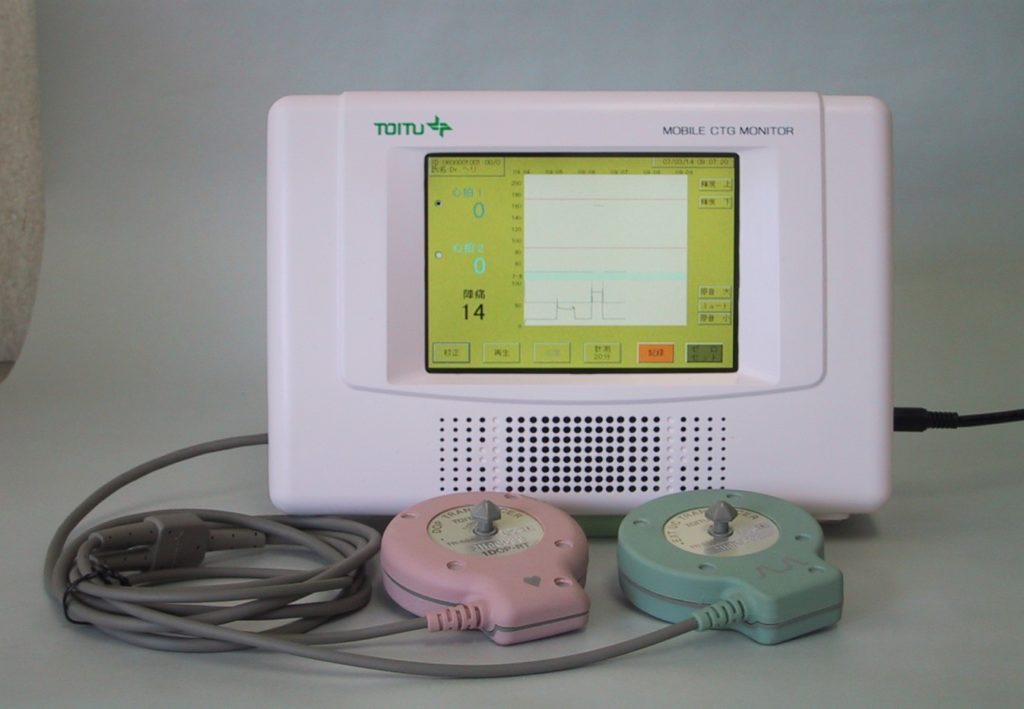
Figure 1. Development of Mobile Home Fetal Monitor (Mobile CTG)
A small mobile system (weight:2.0kg) was developed in response to the spread of mobile environments such as cell phones and smart phones. This enabled pregnant women and doctors to monitor the fetal heart rate from anywhere inside or outside the hospital or clinic.
Concept of the development of the ultra- compact mobile CTG
In developing the ultra- compact mobile CTG (Fetal Monitor iCTG), we did not limit ourselves to conventional technologies, but designed it based on a completely new concept.
1) The system will be mobile and cloud-based, able to send information on fetal heart rate and uterine contractions from anywhere at home and abroad.
2) Fetal heart rate and uterine contractions are recorded on a server in the data center.
3) Eliminate recording paper to achieve a completely paperless system.
4) The electronic circuit of the fetal monitor is miniaturized and placed inside the case of the ultrasound transducer and labor transducer.
5) Displaying fetal heart rate and uterine contractions and the connection to the internet can be done using commercially available tablets instead of a dedicated device.
6) Connecting the ultrasound transducer, labor transducer and tablet via Bluetooth.
7) Use lithium-ion batteries as the power source and use them in a wireless environment (this allows the power supply to be stable even in the region with scarce electricity)
Of these, the most technically challenging was miniaturizing the electronic circuitry of the monitor (ultrasound transmitting and receiving circuitry, fetal heart rate detection circuitry, i.e., analog and digital circuitry) and integrating them into the case of the ultrasound transducer (Figure 2).
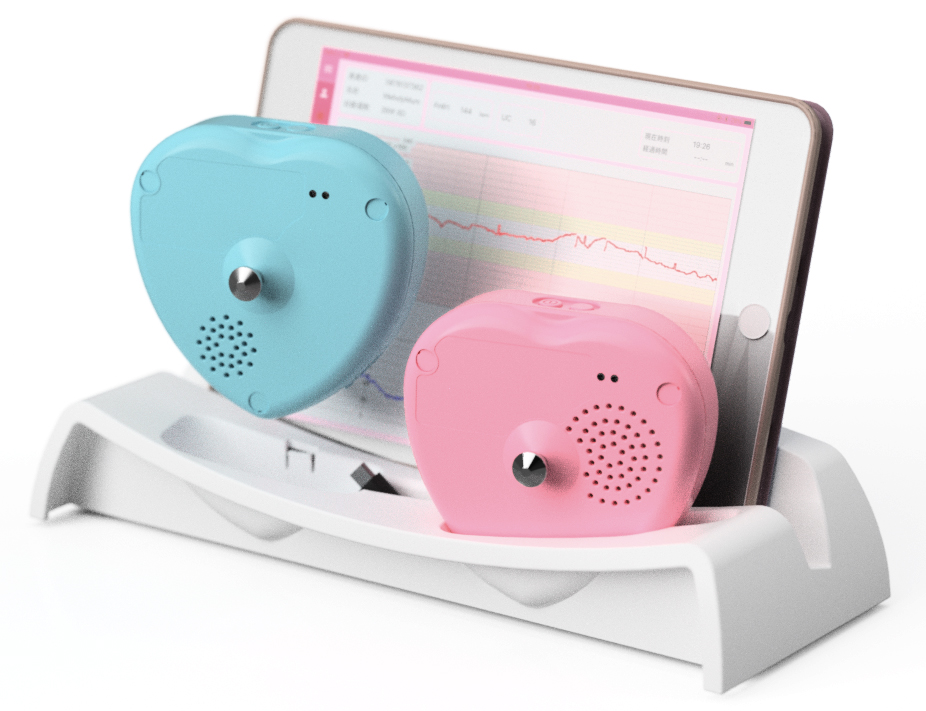
Figure 2. Configuration and actual usage of the ultra- compact mobile CTG (Fetal Monitor iCTG)
It was technologically challenging to downsize and put all the circuitry of the monitor (ultrasound transmitting and receiving circuitry, fetal heart rate detection circuitry) into one case.
Configuration and actual usage of the Fetal Monitor iCTG
The official name of the Fetal Monitor iCTG is Mobile Delivery Monitor, which consists of an ultrasound transducer to detect fetal heart rate, a labor transducer to detect uterine contraction, a tablet, and a set of control software. The control software is to be installed into a tablet (Windows 10 or beyond, iPad). Information transfer between the transducer and the tablet is done via Bluetooth. The fetal heart rate and uterine contraction information sent to the tablet is transmitted via Wi-Fi or 4G(LTE) mobile network within the medical institution or home.
The fetal monitors of the 1970s weighed more than 15kg (including the carriage), so compared to the weight of the Fetal Monitor iCTG (sum of the two transducers are 300g), the weight has been reduced to about1/40 ~1/50 of the monitors from the 70s (Figure 3).
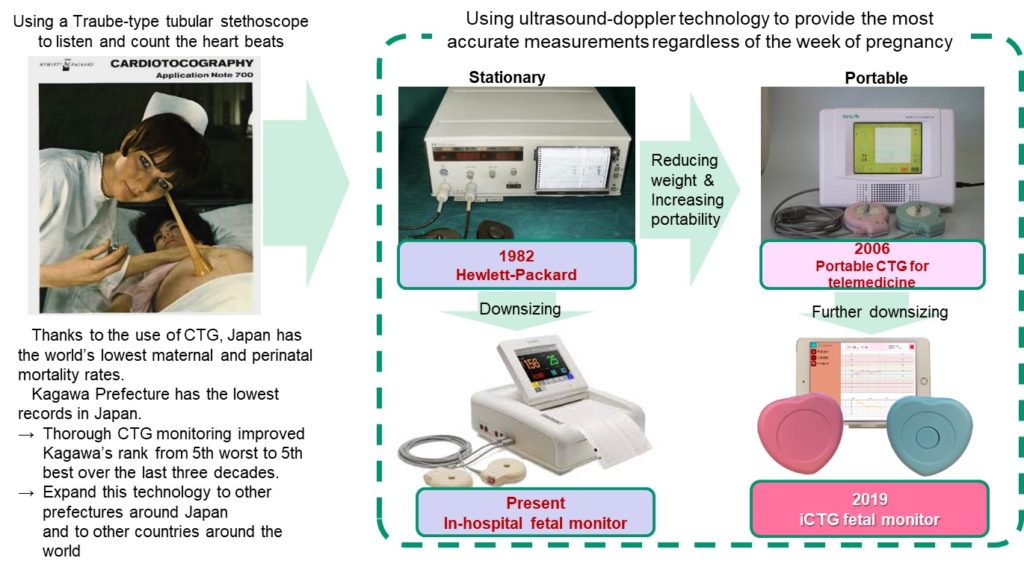
Figure 3. History of the development of a delivery monitoring equipment, from large stationary CTGs to mobile CTG, and ultra-compact Fetal Monitor iCTGs
The fetal monitors from 1970s weighed more than 15kg (including the carriage), whereas the weight of Fetal Monitor iCTG is only 300g (the sum of two transducers), reducing the weight to about 1/40 ~ 1/50 of the original.
Upon actual usage, the heart-shaped wide-beam ultrasound transducer (with a built-in speaker) is placed on the abdominal wall of a pregnant woman and the fetal heart rate variability can be detected very easily by looking for a place where the sound of the fetal heartbeat can be heard. The transducer weighs about the same as a regular smart phone and is completely wireless, so a pregnant woman can easily move around while putting it on (Figure 4).

Figure 4. Further miniaturization of the Fetal Monitor iCTG is now possible.
The accuracy of the fetal heart rate detection has been further improved from the conventional autocorrelation system, and the performance is equivalent to or better than that of conventional fetal monitors.
The accuracy of the fetal heart rate detection has been further improved from the standard autocorrelation system, so the performance is equivalent to or better than that of conventional fetal monitors (Figure 5).
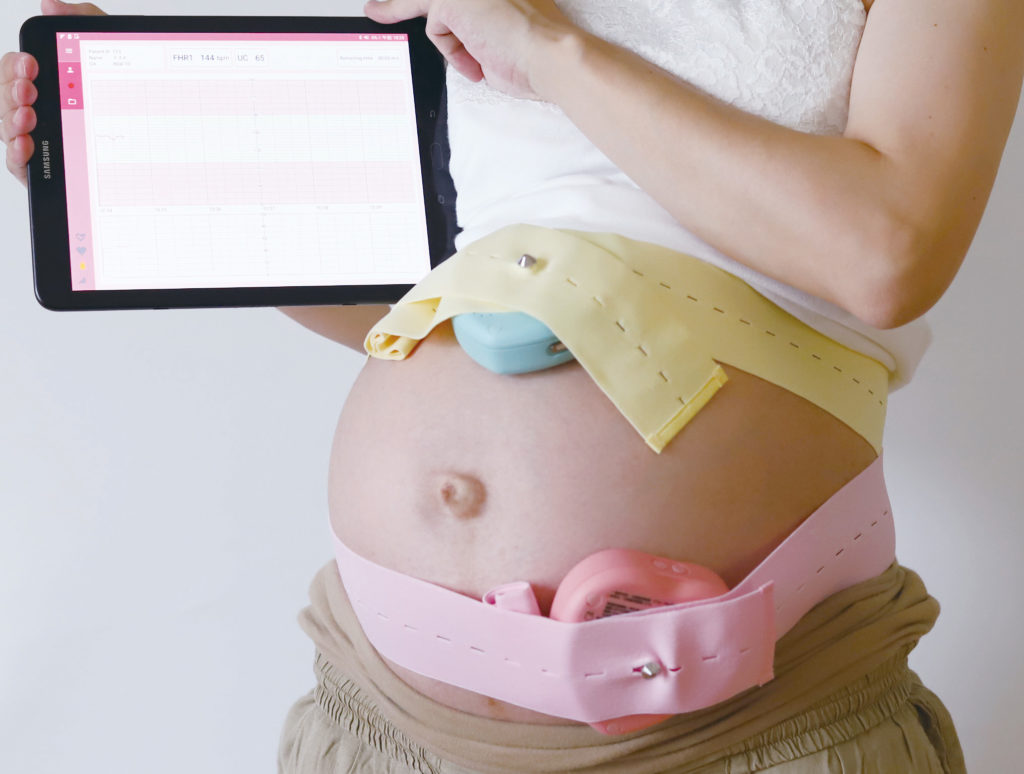
Figure 5. How to put on a Fetal Monitor iCTG
The transducer weighs about the same as a smartphone and is completely wireless, allowing pregnant women to move easily while wearing it on the abdominal wall.
It has been tested not only in Japan, but also in ASEAN countries and African countries. It can be used from anywhere in the world as long as it is connected to the Internet.
A cloud-based, completely paperless Fetal Monitor iCTG that is in line with the era of electronic medical records
Currently, electronic medical records are spreading rapidly in the medical field, and completely paperless is becoming the rule. In addition, cloud-based electronic medical records, which do not require a server in the medical institution, have become the mainstream.
Conventional fetal monitors generally use recording paper, and even recent models have built-in printers for recording. The storage of the recording paper also takes up a considerable amount of space, which is a great burden for medical institutions, but the shift towards paperless fetal monitoring has not progressed well. In addition, it takes a lot of time and effort to find the fetal heart rate on a paper recording form when the need arises later.
In the Fetal Monitor iCTG, usage of recording paper was eliminated from the designing stage. Data are permanently stored on a cloud server with adherence to the standard format for recording fetal heart rate. This eliminates the need for storage space in medical institutions and allows easy retrieval of fetal heart rate data at any time, following the trend of the current medical field.
Fetal heart rate information file data format by the Japan Association of Obstetricians and Gynecologists.
To transmit the fetal heart rate over a network, standardization of digitalization is essential; therefore, the Japan Association of Obstetricians and Gynecologists has specified the fetal heart rate information file data format in 1999, and the Japan Society of Obstetrics and Gynecology and the Japan Association for Medical Informatics have also approved it. 6)
This format will allow easy and accurate display of fetal heart rate and uterine contractions, even between different devices. It’s clinical significance is very high, as it will enable the management of high-risk pregnant women at home anytime, anywhere, and even in the entire community.
“Fetal heart rate information file Data format standard”
https://www.jaog.or.jp/sep2012/JAPANESE/ jigyo/JOUHOU/H10/shinpaku.htm
- Example of the structure of a fetal heart rate information file
When a delivery monitoring device outputs measurement data digitally, fetal heart rate data as well as labor and fetal movement data are sampled at different time intervals and sent in multiplexed 1 packet.
The figure6 shows an example data transmission format of the delivery monitoring device. The fetal heart rate is sampled 4 times per second (8 times in the case of twins). Labor pains are sampled at the rate of once per second, as well as the fetal movements.
H: Heart rate
250 msec (4 times per second)
U: Uterus Contraction
1 sec (once per second)
A: Fetal movement
1 sec (once per second)

Figure 6. Fetal heart rate information file data format by the Japan Association of Obstetricians and Gynecologists.
This format allows for easy and accurate display of fetal heart rate and uterine contractions, even between different devices.
- Fetal Heart Rate information
The fetal heart rate information file consists of a header section and a wave pattern data section. The header part comprises of identification ID and header data, which allows the heart rate data to be displayed accurately even when output is made from different devices. By digitizing the fetal heart rate in a standardized way, it can be easily and reliably transmitted in a mobile environment.
Remote pregnancy management for pregnant women around the world
The Fetal Monitor iCTG is both a medical device that is connected to an internet network, allowing pregnant women, midwives, and doctors to share data even if they are in different locations. Doctors can diagnose pregnant women in distant locations and give appropriate instructions. In addition, real-time information sharing among multiple medical institutions allows cooperation between clinics and core hospitals, between homes and core hospitals, or between ambulances and core hospitals.
We have been developing this technology in Hokkaido, Iwate Prefecture, and Amami Oshima Island in Japan, as well as in Thailand, South Africa, Bhutan, Myanmar, and other developing countries, with support from JICA, the Ministry of Internal Affairs and Communications, and the United Nations.
JICA grassroots technological cooperation project taking place in Chiang Mai, Thailand which started from 3 hospitals is receiving high reputation, resulting in expansion of the project to 25 regional public hospital to cover entire prefecture to decrease the perinatal mortality rate.
Such outcomes have been recognized by the United Nations, and now under the framework of United Nations Development Programme (UNDP) we have installed Fetal Monitor iCTG (55 devices) into Bhutan, a country with many mountainous terrains, to improve its delivery and birth situation.
Utilization of Fetal Monitor iCTG in midst of COVID-19 outbreak
The epidemic of the COVID-19 infection has drawn attention to the use of Fetal Monitor iCTG for online maternal health checkups. There are two main types of possible usage for that purpose.
1) Use at home to prevent infection due to frequent hospital visits
2) In the case of a pregnant woman who has already been infected, the pregnant woman is to be placed in an isolation ward set up in the hospital, and she is monitored remotely from the maternity ward. In case of labor, the delivery is handled in a delivery facility (even a temporary delivery room) prepared for infected pregnant women (Figure 7).
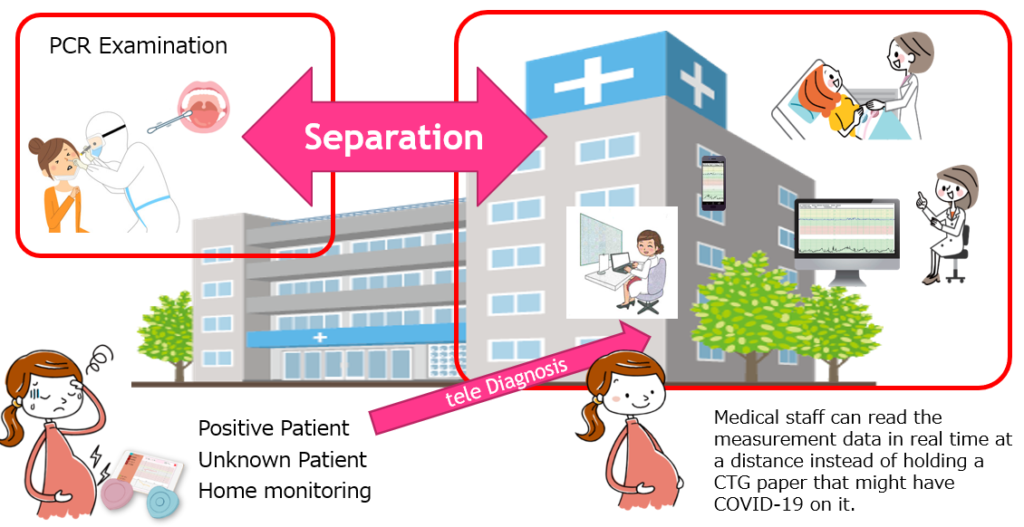
Figure 7. Response to COVID-19 infections: Prevention of infection in obstetrics and gynecology (in-hospital isolation)
It can be used at home to prevent infection, or in isolation wards for pregnant women who have already been infected.
Recently, the number of pregnant women infected with COVID-19 has been increasing rapidly, resulting in a situation where medical institutions are unable to accommodate them, which has become a social problem. If Fetal Monitor iCTG is used, there is no need for hospitalization facilities dedicated to pregnant women. Instead, pregnant women can be remotely managed by dispersing them to other medical institutions for general COVID-19 patients, medical treatment facilities, or their homes. Once the labor begins, or in case of recognizing abnormality, pregnant woman can be transported to delivery facility. In this way, the burden on medical institutions in the entire region can be reduced.
Conclusion
The most important performance requirement for a delivery monitoring device is that it should be able to always detect the fetal heart rate stably from the middle of pregnancy onward, i.e., it should be all- weather type. Many methods have been tried, but at present, Doppler heartbeat signals based on autocorrelation method are used most.
Fetal Monitor iCTG, the subject of this paper, uses the autocorrelation method to measure fetal heart rate, and its performance is as good as or better than a conventional fetal monitor.
Fetal Monitor iCTG is cloud-based and can be used anywhere in the world as long as there is an Internet connection, and it is technically possible to manage all the fetuses in the world with Fetal Monitor iCTG in the near future.
There is a recent trend known as IoT (Internet of Things) but I am envisioning IoF (Internet of Fetus) where fetuses can be monitored and managed for a safe delivery everywhere in the world.
This study was supported by the Ministry of Internal Affairs and Communications, the Ministry of Economy, Trade and Industry, the Ministry of Health, Labour and Welfare, the United Nations Development Programme (UNDP), the Japan Association of Obstetricians and Gynecologists, and the Japanese Telemedicine and Telecare Association.
References:
- Sakamoto, S., Hogaki, M., Hara, K., Takeuchi, Y. (1975): Development of Obstetric ME, Obstetrical and Gynecological Therapy, Vol.30, No. 6, pp.595-pp.601
- Hara, K. (1997) One Condition for Systematizing Kagawa Prefecture’s Medical Care, Implementing New Media for Obstetrics and Gynecology. Kagawa Economy Research Institute Monthly Report, No. 60, pp.27-pp.35
- Hara, K. (2009) Home-Based CTG and its Transmission System, Perinatal Medicine, Vol. 39, No. 4, pp.423-pp.430
- Hara, K. (2010) IT to Save Destruction of Perinatal Medicine, Information Processing, Vol. 15, No. 8, pp.1039-pp.1048
- Hara, K. (2014) From Regional Medical Cooperation to Global Expansion – The Aim of Kagawa Medical and Social Welfare Comprehensive Special Zone’s Telemedicine, Next.com, KDDI Research, Vol. 15, pp.04-pp.11
- Hara, K., Okada, H., Norimatsu, H. (2000) Standardization of Perinatal Medical Information with “Nichi-bo Standard Format” and Development of Perinatal Monitoring System Using a Network, Japan Journal of Medical Informatics, Vol. 20, No. 2, pp.143-pp.148
- Hara, K. (2017) Mobile CTG, a Perinatal Monitoring System Made in Kagawa, and its Path to Global Expansion. Hyakujushi Research Institute Monthly Report, No. 358, pp.2-13
- Hara, K. (2018) A Near Future of Obstetrics and Gynecology: Using a Cloud Storage Type Ultra-Small Mobile CTG, Japan Association of Obstetricians and Gynecologists Training Note, No. 100, pp.55
- Hara, K. (2019) Invitation to “Communities, People and Work Creation Conference” held at Prime Minister’s Office – Approval of super downsized mobile CTG (Petit CTG) as medical device, 114 economic research survey monthly report Number 384: pp.16-24
- Hara, K. (2019) Remote fetal diagnosis using a mobile fetal monitor (petit CTG), Obstetrical and Gynecological Practice, No. 73, pp.1179-pp.1187
